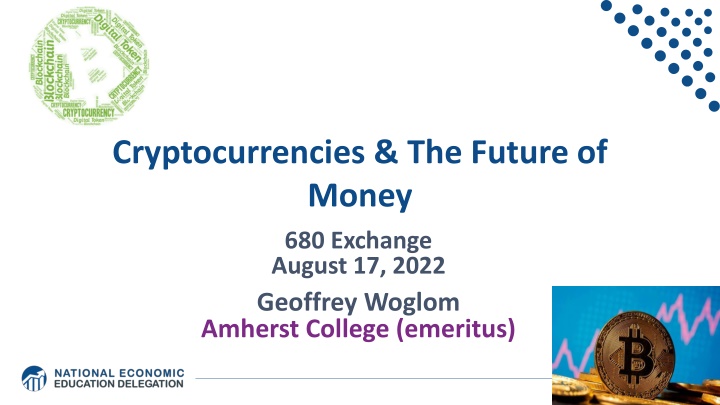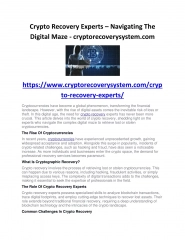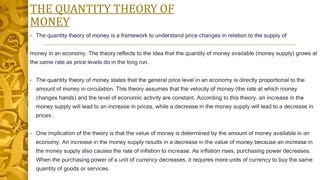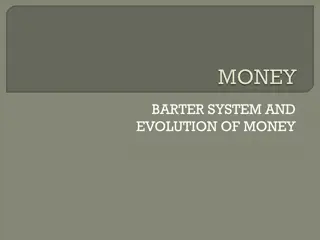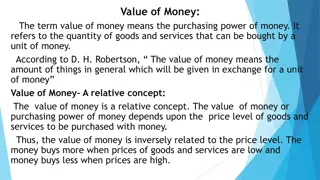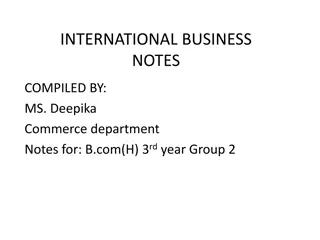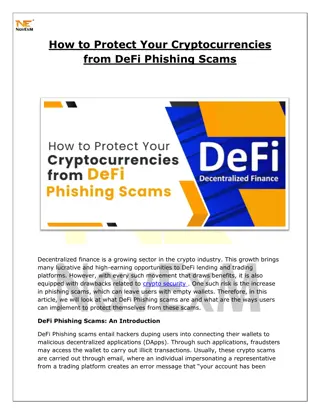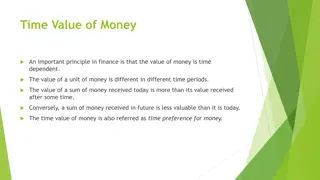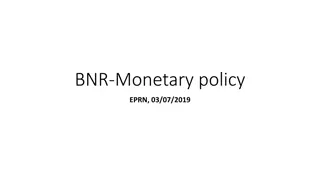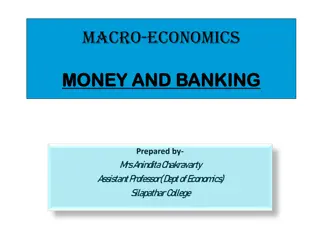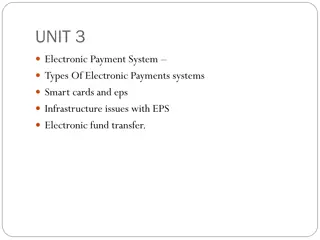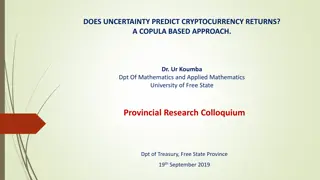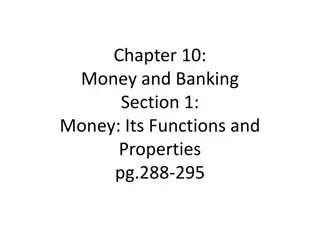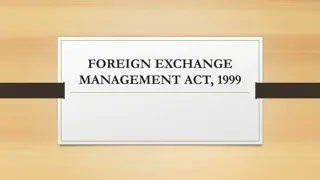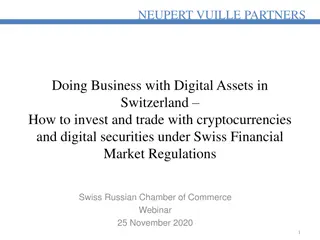Cryptocurrencies & the Future of Money Exchange
This presentation explores the role and potential of Bitcoin and other cryptocurrencies in the digital economy. It delves into the underlying technology, economist evaluations, and prospects for regulation in the crypto space.
Download Presentation

Please find below an Image/Link to download the presentation.
The content on the website is provided AS IS for your information and personal use only. It may not be sold, licensed, or shared on other websites without obtaining consent from the author.If you encounter any issues during the download, it is possible that the publisher has removed the file from their server.
You are allowed to download the files provided on this website for personal or commercial use, subject to the condition that they are used lawfully. All files are the property of their respective owners.
The content on the website is provided AS IS for your information and personal use only. It may not be sold, licensed, or shared on other websites without obtaining consent from the author.
E N D
Presentation Transcript
Cryptocurrencies & The Future of Money 680 Exchange August 17, 2022 Geoffrey Woglom Amherst College (emeritus) 1
National Economic Education Delegation Vision - One day, the public discussion of policy issues will be grounded in an accurate perception of the underlying economic principles and data. Mission - NEED unites the skills and knowledge of a vast network of professional economists to promote understanding of the economics of policy issues in the United States. NEED Presentations - Are nonpartisan and intended to reflect the consensus of the economics profession. 2
Who Are We? Honorary Board: 54 members - 2 Fed Chairs: Janet Yellen, Ben Bernanke - 6 Chairs Council of Economic Advisers o Furman (D), Rosen (R), Bernanke (R), Yellen (D), Tyson (D), Goolsbee (D) - 3 Nobel Prize Winners o Akerlof, Smith, Maskin Delegates: 651+ members - At all levels of academia and some in government service - All have a Ph.D. in economics - Crowdsource slide decks - Give presentations Global Partners: 49 Ph.D. Economists - Aid in slide deck development 3
Available NEED Topics Include: Healthcare Economics Immigration Economics US Economy Housing Policy Climate Change Federal Budgets Economic Inequality Federal Debt Economic Mobility Black-White Wealth Gap Trade and Globalization Autonomous Vehicles Minimum Wages US Social Policy 5
Outline of the Talk Fun Facts about Bitcoin A little bit on the underlying technology of bitcoin. Economist evaluation of 2 Key Questions 1. Is Bitcoin serving a legitimate economic role? 2. Is there potential for beneficial, financial innovations using the underlying technology? Prospects for regulation of the crypto space. 6
But First, What is Bitcoin? Bitcoin is the first cryptocurrency and was invented in 2008. Cryptocurrencies are a form of digital money (viz. data on a computer) where account ownership is confidential and where record keeping is decentralized over a multitude of computers More importantly, 7
Bitcoin Has Started a Revolution in Finance 1. The way we buy and sell things, our payments system; the way we save, borrow and invest; the role of banks and other financial firms are rapidly changing. 2. In my view, Bitcoin will NOT be an important player in these developments, but the technologies underlying Bitcoin may be. 8
Bitcoins: What Is All the Excitement About? Was $23,400, 0n 8/17, 10:30 AM 9
Facts about Cryptocurrencies (as of 8/17) Bitcoin was the first and is the largest in terms of market cap (total value of all bitcoins) of about $450 billion. Ethereum is in second place with a market cap of about $220 billion. Presently, 11,500 different varieties with a total market cap of about $1.2 trillion (https://www.coingecko.com/en) Market cap of domestically listed US companies is about $40 trillion. 12
An Origin Story Worthy of a Pulp Novel! The Mysterious Satoshi Nakamoto: - Lehman Brothers Bankruptcy, 9/2008 - Halloween 2008: a white paper is published on the Internet laying out the idea and design for Bitcoin. The author (or authors) used Satoshi Nakamoto as a pseudonym. - January 2009: Satoshi releases the first version of the Bitcoin software. - 2009-2010: Satoshi releases new versions of the software and is actively involved in Internet Chatter about Bitcoin. - April 2011: Satoshi ceases all known and/or verified communications. To this date the identity or identities of Satoshi are unknown. 13
The Possible Economic Role for Bitcoin Satoshi s Vision: A purely peer-to-peer version of electronic cash [that] would allow online payments to be sent directly from one party to another without going through a financial institution. More, prosaically 1. Facilitate payments at lower costs with speed and securit 1. E.g., Credit Card Fees (3 percent). 2. Merchant doesn t get paid for at least 2 days. 3. More importantly, cross-border transactions costs were $1.9 trillion in 2018. 4. 2019 Capital One hackers access personal information of 106 m users 2. Meet the needs of previously unbanked. 1. Particularly a problem in the Developing World, but 2. Fed estimates that 50 million US adults have little or no banking relationships. 14
Underlying Technology of Bitcoin 1. Digital Token (exists only as data on a computer) whose ownership is cryptographically protected. 2. Distributed Ledger, Block Chain Technology. 3. Software protocol the provides a consensus mechanism on the validity of new transactions. Payments based on trust, without a trusted third party. (i.e, a bank or the Fed). 15
So, how does it work? Jack, the owner of a bitcoin is given a public number or key and a private encrypted key. Jack can trade his bitcoin with Jill by using Jill s public key and verifying the transaction with his private key. The new transaction is then posted on a a number of different computers and can be read by anyone. The clearing of the transaction is done with public database or distributed ledger called a blockchain through a process know as bitcoin mining. First, Bitcoin Miners gather about 3000 new transactions into a block. Bitcoin miners then engage in an elaborate computational tournament to determine who adds the new transactions to the blockchain 16
Bitcoin Mine 17
Mining for Bitcoin The miners competition involves generating long, random numbers ( hashing ) until one of the numbers fits a precise set of attributes. Presently, miners produce on the order of 200 million trillion random numbers per second. The winning miner then adds the new block to the previous block in the blockchain. The total process takes about 10 minutes The incentive for miners is that the winner of the competition gets compensated with new bitcoins and transaction fees. However, the miner will not get the reward unless other miners subsequently add new blocks to the first miner s block. In this way transactions are added to the chain via a consensus of miners. 18
Question #1: Is Bitcoin serving an economic role Bitcoin is not and cannot be widely used to make transactions Scalability? Price Instability. Transactions costs And, the network is costly 1. Resources used in mining 2. Environmental Costs BIS, Annual Report 2018, Chapter V 19
What Role Does Bitcoin Play? For some it plays the same role as $100 bills: 32.8% of all bills in circulation (more than the number of $1 bills) Illegal Activity 20
But What about as an Financial Investment? It is hard to argue with the fact that Bitcoin had provided outsized returns for many, albeit very volatile. Financial Assets are Promises by the Issuer - Bond payment of coupons and repayment of principal in the future - Stock payment of dividends in the future; voting rights - Options or Futures payments of money conditional on future info. - Currency promise that it will be acceptable for payments in the future with stable value The fundamental value of a financial assets is the value of those promises. What does Bitcoin promise? 22
How Do Economist Think About Investments? Good Starting Place In the short term the stock market behaves like a voting machine, but in the long term it acts like a weighing machine. What is being weighed is prospective payments from the security, or other intrinsic value, i.e. its fundamental value. Bitcoin? 23
Algorithmic Stablecoin Create a regular cryptocurrency and call it say, luna. If it has value, create a stablecoin and call it say, terra, that is tied to luna. You can always exchange terra into $1 worth or luna, or vice versa Luna = $10, terra = $1, trade 1 luna for 10 terra Luna = $1, terra =$1, trade 1 luna for 1 terra and vice versa Terra price drops to $0.80, buy luna with terra Terra price rises to $1.20, buy terra with luna What could go wrong? 25
Lunas Price This Year https://coinmarketcap.com/ 26
Terras Price Death SpiRal!!! 27
Question #2: The Value of the New Technology? Don t Throw the baby out with the bathwater! The value cryptographically protected digital-tokens is nuanced: Blockchain technologies have significant promise some of which is already being realized. - Private blockchains, Walmart and its produce suppliers - Public Blockchains, Ethereum and smart contracts See: Mehta N,. Agashe A., P. Detroja Blockchain Bubble or Revolution, 2021 28
Smart Contracts on the Blockchain A Smart Contract is a computer code that resides on the block chain and is executed based on incoming information. Example, Parametric Hurricane Insurance via the Blockchain: - Computer program on Ethereum continuously monitors Charleston Executive Airport wind speed for 1 year. - If the windspeed is greater than 150 miles per hour, immediately transfers 100 bitcoin to the Seabrook Island Property Association. - If the windspeed is less than 150 miles per hour, but more than 125 miles per hour, immediately transfers 75 bitcoin; etc. Smart Contracts are Automatic, Immediate, Irreversible and Uncontestable. DEFI, but note bitcoin is not good in my insurance example 29
Three Recent US Government Reports Presidential Working Group on Financial Markets on Stable Coins and CBDC, 11/2021. Federal Reserve Discussion Paper on CBDCs, 1/2022 Executive Order of the President, 3/09/2022 1. (a): fraud; (b) stability; (c ) illicit activity; (e ) equitable access 2. (d): We must reinforce United States leadership in the global financial system and in technological and economic competitiveness. 3. (f) support responsible innovation; 4. (g) explore Central Bank Digital Dollar (government issued: Stablecoin ) 30
The Devil Is In the Details Over 100 countries as diverse as Sweden, Ecuador and China have begun experiments with CBDCs. Where s the Fed? Source: E. Prasad, The Future of Money 31
Resources to Learn More N. Mehta, et.al. Blockchain Bubble or Revolution E Prasad, The Future of Money (https://youtu.be/o3NuHb7V1IA) Presidential Working Group on Financial Markets, 11/1/21 (https://home.treasury.gov/system/files/136/StableCoinReport_Nov1_5 08.pdf) Federal Reserve White paper (https://www.federalreserve.gov/publications/files/money-and- payments-20220120.pdf) Executive Order: https://www.whitehouse.gov/briefing- room/statements-releases/2022/03/09/fact-sheet-president-biden-to- sign-executive-order-on-ensuring-responsible-innovation-in-digital- assets/ 33
Glossary Traditional Money is currency plus bank checking accounts. Currency is paper and coin issued by the government. Currency is legal tender and must be accepted for all debts. Transactions using currency are immediate and final (can t be undone without the agreement of both parties.) Digital Payments are used for purchases where no physical money is exchanged. Examples include many online banking payments, credit card payments, PayPal. Digital Currency or Virtual currency is a form of money that exists solely in digital form, such as a digital token (i.e., as data on a computer). Examples: cryptocurrencies, central bank digital currencies and virtual currencies used in online gaming. Cryptographic identity protection assigns people two account numbers, or keys, one public and one private. Public record keeping is done using the public key and transactions are authorized using the private key. Cryptocurrency is a digital currency where the owner s identity is protected using cryptographic encryption and where record keeping is done with a public blockchain, e.g., Bitcoin. Stablecoin is a cryptocurrency with a stable value of $1, somewhat like a money market mutual fund. 34
Glossary (Cont.) Distributed ledger is a database for recording transactions or other information, where the information or ledger is shared on a network of many computers simultaneously. Blockchains are distributed ledgers where new transactions (new blocks) are added to the chain sequentially when a consensus of the network agrees that the transactions are valid. Decentralized Finance (DeFi) is peer-to-peer financial activity conducted through public blockchains and smart contracts. Smart Contracts are computer programs that execute automatically based on external conditions. Example, travel insurance that pays off automatically when a flight is cancelled. Central Bank Digital Currency (CBDC) is a digital currency issued by a central bank. Different central banks are experimenting with various forms of CBDCs, including some using blockchain technology, electronic wallets and cryptography. 35
Questions? www.NEEDelegation.org Geoffrey Woglom grwoglom@amherst.edu Contact NEED: Info@NEEDelegation.org Submit a testimonial: www.NEEDelegation.org/testimonials.php Support NEED: www.NEEDelegation.org/donate.php 36
